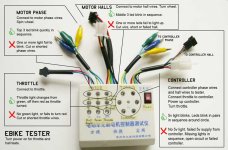coloradoebiker
100 mW
Hello All,
I'm somewhat of a newbie here. I have a Jamis Dakar fitted with a Phoenix/Crystalyte x5303 motor (1st generation with no disc brake). A couple months ago, I stupidly tried to climb a sidewalk curb from a stop and broke something within the Crystalyte x5303 motor. I remember that as I was trying to climb the curb, the motor hesitated for a moment before giving out. Not good.--It was followed by the dreaded walk of shame back to the car.
I remember that as I was trying to climb the curb, the motor hesitated for a moment before giving out. Not good.--It was followed by the dreaded walk of shame back to the car.  Anyways, now I'm looking to ES for some pointers as to how to start diagnosing the problem so I can get it fixed.
Anyways, now I'm looking to ES for some pointers as to how to start diagnosing the problem so I can get it fixed.
In its current state, the symptoms are as follows:
When throttle is twisted, the motor or control makes a "click" sound but nothing happens.
The rear wheel is locked up/hard to turn.--When riding, it wobbles and has quite a bit of resistance.
I have since pulled the motor out of the hub casing and it is ready for testing. Feel free to provide some pointers as this is all new to me.--or if there are any threads you can reference, that works as well.
I'm somewhat of a newbie here. I have a Jamis Dakar fitted with a Phoenix/Crystalyte x5303 motor (1st generation with no disc brake). A couple months ago, I stupidly tried to climb a sidewalk curb from a stop and broke something within the Crystalyte x5303 motor.
In its current state, the symptoms are as follows:
When throttle is twisted, the motor or control makes a "click" sound but nothing happens.
The rear wheel is locked up/hard to turn.--When riding, it wobbles and has quite a bit of resistance.
I have since pulled the motor out of the hub casing and it is ready for testing. Feel free to provide some pointers as this is all new to me.--or if there are any threads you can reference, that works as well.





